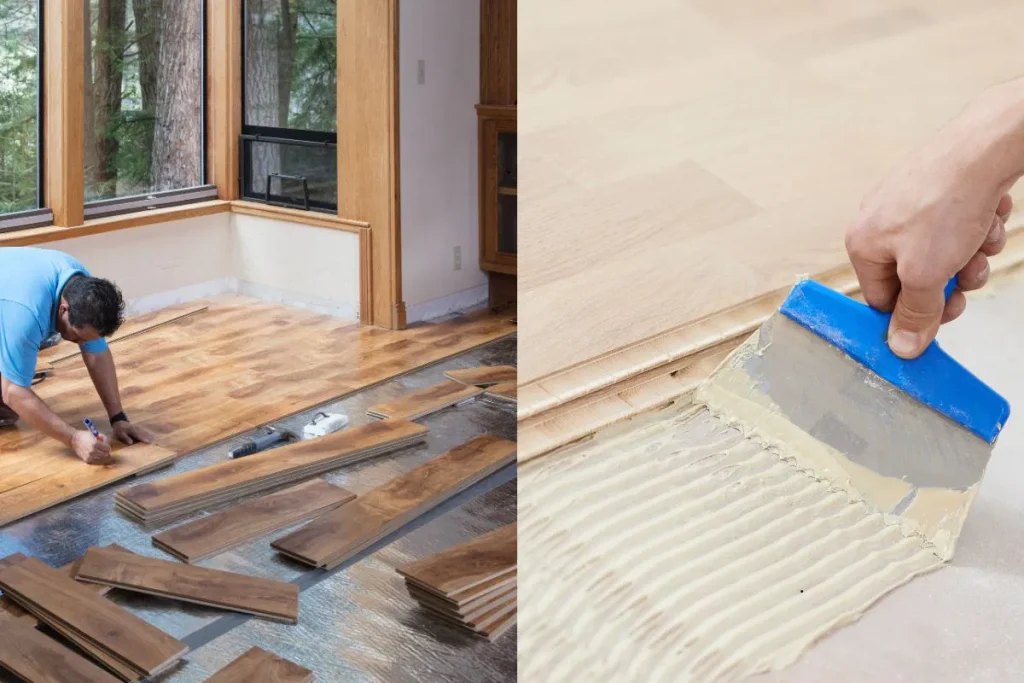Written by Nyla Thompson, founder of DecorifyIt and a home improvement specialist with over 15 years of experience helping homeowners transform their spaces through practical, stylish renovations.
Deciding between glue down and floating hardwood floors isn’t just a technical choice—it impacts how your home feels, sounds, and even ages over time. I’ve guided dozens of clients through this exact decision, and here’s what I’ve learned from seeing these installations succeed (and occasionally go wrong) in real homes.
Let’s break down the pros, cons, and insider tips—based on real-world results.
What’s the Difference in Practice?
If you’re comparing these two options in a flooring showroom, they might seem similar. But when I’m on-site during installations, the difference becomes clear quickly.
Glue down hardwood flooring involves applying adhesive directly to the subfloor before placing each plank. It creates a tight, stable finish that feels solid underfoot—like traditional hardwood should.
Floating floors, which I often recommend for flats or upper-storey renovations, lock into place over an underlay without being fixed to the floor beneath. This allows them to adapt more easily to slight imperfections in the subfloor and changing humidity levels.
Why Glue Down Works So Well in Permanent Homes
1. That “Real Wood” Feeling
Clients often describe glue-down floors as “solid” or “quiet,” and they’re right. Once installed, they don’t shift or creak much—especially on concrete subfloors. One couple I worked with in Manchester loved how their oak glue-down floor made their entire ground floor feel anchored and premium.
2. Sound Absorption
For busy family homes, especially those with kids upstairs, this option reduces footstep noise significantly. In one semi-detached house in Birmingham, we noticed a 30–40% drop in echo after replacing floating laminate with glued-down engineered planks.
3. Works Great Over Concrete
In new builds or basement conversions where concrete is the norm, glue down is usually the go-to. Just remember: always install a moisture barrier. I’ve seen floors bubble or cup when this step was skipped.
4. Built for Decades
When clients ask me what flooring they can “grow old with,” this is it. Thick glued-down floors can be refinished two or even three times, which means they can survive kids, pets, furniture moves—and still look beautiful.
Challenges with Glue Down
1. Not a DIY-Friendly Project
I’ve had clients try it themselves and then call me in to “fix the mess.” Getting the adhesive right, aligning planks perfectly, and maintaining expansion gaps is harder than YouTube makes it look.
2. Repairs Aren’t Easy
In a recent project, a single plank was damaged during a remodel. Because it was glued, we had to remove three surrounding planks just to get to it. That’s why I tell homeowners: glue-down is durable, but not very forgiving.
3. Installation Costs More
Between the extra time, materials, and professional labour, glue-down floors typically cost 20–30% more than floating options upfront. That said, the long-term value often balances it out.
When Floating Floors Make More Sense
1. Quick and Clean Installation
I recently helped a young couple renovate their first flat in London. They were on a tight timeline and budget. We installed a floating engineered wood floor in two days—with no glue, no fumes, and no need for sanding.
2. More Affordable
Since you don’t need adhesive or extensive prep, floating floors are often 15–25% cheaper to install. For homeowners focused on stretching a renovation budget, this is a great option.
3. Perfect for Temporary or Changing Spaces
In rental properties or second homes, I almost always recommend floating floors. They’re easier to replace, and if you move furniture often (or redecorate every two years like some of my clients do), floating planks allow more flexibility.
4. Can Go Over Almost Anything
As long as the surface underneath is flat, floating floors can be installed over old tiles, vinyl, and even worn-out hardwood. In one farmhouse conversion in Yorkshire, we floated over the original 1920s boards to preserve the structure underneath.
5. Adaptable to Humidity
Thanks to built-in expansion gaps, floating floors handle moisture changes better. This is why I often suggest them for rooms near conservatories or for loft conversions where climate control isn’t always ideal.
Floating Floor Drawbacks
1. Slight Movement
One client did notice a bit of bounce near the doorway after we installed a floating system over old tiles. We added a more supportive underlay, which helped—but it’s a reminder that floating doesn’t always feel as firm as glue-down.
2. Can Be Noisier
Cheap underlays and poor prep can lead to squeaks and echoing. I always tell my clients: invest in quality underlay—it makes a huge difference in sound and feel.
3. Water Sensitivity
Floating floors don’t mix well with damp basements or bathrooms unless you’re using waterproof planks. Even then, a waterproof seal around the edges is essential. I’ve had to redo bathroom floors where splash zones were underestimated.
My Verdict: It Depends on Your Goals
If you’re planning to stay in your home long-term and want a timeless, solid floor that adds value, glue down is usually worth the investment.
But if you’re on a tighter budget, renovating a rental, or just want to keep your options open for future updates, floating floors are the smart, flexible choice.
For engineered hardwood, both methods work, but glue-down usually provides better long-term stability—especially if the planks are over ½ inch thick.
Maintenance Tips I Share with Every Client
No matter which method you go with, here’s how to keep your floor looking like new:
- Avoid steam mops or excessive moisture
- Use microfibre or non-abrasive cleaners
- Add rugs to high-traffic areas
- Stick felt pads under all furniture legs
Glue-down floors can often be refinished, while most floating floors are better suited to replacement rather than resurfacing.
Quick Comparison Table
| Feature | Glue Down Floors | Floating Floors |
|---|---|---|
| Installation | Professional, adhesive-based | DIY-friendly, click-lock |
| Stability | Very firm | Moderate to soft |
| Noise Level | Quiet | Can be loud without underlay |
| Best For | Long-term/permanent homes | Rentals, quick renovations |
| Refinishing Potential | High | Low to none |
| Repair Ease | Difficult | Easy to replace |
| Installation Cost | Higher | Lower |
| Moisture Handling | Needs barrier | Built-in expansion space |
Final Thought from the Job Site
Whether I’m standing in a sleek modern kitchen or a 100-year-old cottage, one thing holds true: your flooring sets the tone for the whole space. Choosing the right method isn’t just about the product—it’s about how it fits into your life.
Still not sure? Feel free to get in touch via DecorifyIt. I’m always happy to help you make the right call for your home and budget—because great design starts with strong foundations.

